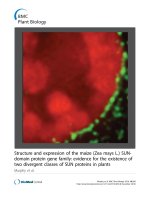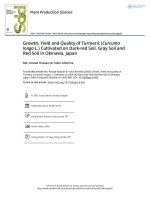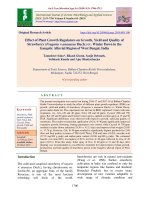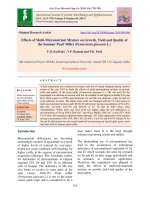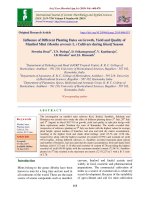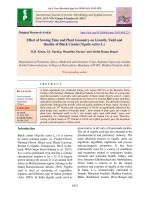Combining ability for traits associated with yield and quality of sweet corn (zea mays l saccharata)
Bạn đang xem bản rút gọn của tài liệu. Xem và tải ngay bản đầy đủ của tài liệu tại đây (1.29 MB, 100 trang )
VIETNAM NATIONAL UNIVERSITY OF AGRICULTURE
FACULTY OF AGRONOMY
UNDERGRADUATE THESIS
TITLE OF RESEARCH: “COMBINING ABILITY FOR
TRAITS ASSOCIATED WITH YIELD AND QUALITY
OF SWEET CORN (ZEA MAYS L. SACCHARATA)”
Student
: Ngo Thi Nhung
Student code
: 611712
Class
: K61KHCTT
Instructor
: Prof. PhD Vu Van Liet
Department
: Plant Genetics and Breeding
Ha Noi - 2021
ACKNOWLEDGEMENTS
I would like to express my respect and deep gratitude to Prof. PhD Vu
Van Liet, for giving me the opportunity to carry out this work, and his huge
efforts, enthusiasm, and support throughout the duration of the undergraduate
thesis.
I would like to express sincere gratitude to MSc. Tran Thi Thanh Ha and all
the members of Research and Technology Development Plant – Crop Research
Institute and Plant Development were enthusiastic to help me through the project.
I would also like to thank the Directors, Management Training, Department
of Genetics - Plant Breeding, Faculty of Agronomy – Vietnam National University
of Agriculture (VNUA was dedicated to help me during earning process, to
complete the thesis.
Finally, I would like to thank my family, those with us and those sadly
departed. You provided fantastic support and inspiration throughout the duration
of this undergraduate thesis, and without you all, this would never have been
possible.
Hanoi, 1st March 2021
Student
Ngo Thi Nhung
i
CONTENTS
ACKNOWLEDGEMENTS .............................................................................................. i
CONTENTS...................................................................................................................... ii
LIST OF ABBREVIATIONS ......................................................................................... iv
LIST OF TABLE ...............................................................................................................v
LIST OF FIGURES ........................................................................................................ vii
ABSTRACT................................................................................................................... viii
I.
INTRODUCTION ....................................................................................................1
1.1. Introduction.................................................................................................................1
1.2. Objectives and requirements ......................................................................................3
1.2.1. Objectives ................................................................................................................3
1.2.2. Requirements ...........................................................................................................3
II. LITERATURE REVIEW ........................................................................................4
2.1. Sweet corn production in the world and in Vietnam .................................................4
2.1.1. Sweet corn production in the world. .......................................................................4
2.1.2. Sweet maize production in Vietnam .......................................................................7
2.2. Origin and classification of sweet maize ...................................................................9
2.3. Genetics of sweet maize .......................................................................................... 12
2.5. Combining ability .................................................................................................... 17
2.5.1. General combining ability .................................................................................... 19
2.5.2. Specific combining ability ................................................................................... 19
III. MATERIALS AND METHODS.......................................................................... 21
3.1. Materials .................................................................................................................. 21
3.2. Location and time of research ................................................................................. 21
3.3. Research content ...................................................................................................... 21
3.4. Experiment design: .................................................................................................. 22
3.5. Field experiments: ................................................................................................... 22
3.6. Data collection ......................................................................................................... 25
ii
IV. RESULT AND DISCUSSION .............................................................................. 36
4.1. Growth duration of sweet maize hybrids tested in the Autumn- Winter season of
2020 in Gia Lam, Ha Noi. ...................................................................................... 36
4.2. Some morphological characteristics of sweet maize hybrids in Autumn-Winter
season of 2020 at Gia Lam, Ha Noi ....................................................................... 41
4.3. Leaf area and leaf area index of the sweet maize hybrids in the experiment in
Autumn Winter 2020 in Gia Lam, Hanoi .............................................................. 44
4.4. The pest and disease resistance in the field of the sweet corn hybrids in the
experiment in Autumn Winter season 2020 at Gia Lam, Hanoi. .......................... 45
4.5. Ear morphological characteristics of sweet maize hybrids in the Autumn Winter
2020 experiment at Gia Lam, Hanoi...................................................................... 49
4.6. The yield and yield components of the sweet maize hybrids in the Autumn Winter
2020 experiment at Gia Lam, Hanoi...................................................................... 52
4.7. Some sensory quality traits of sweet maize hybrids in Autumn Winter 2020
experiment at Gia Lam, Hanoi. .............................................................................. 56
4.8. Combining ability of sweet maize parent lines in Autumn-Winter 2020 experiment
at Gia Lam, Ha Noi. ............................................................................................... 59
4.8.1. Combing ability of sweet maize parent lines associated for yield in AutumnWinter 2020 experiment at Gia Lam, Ha Noi. ...................................................... 59
4.8.2. Combing ability of sweet maize parent lines associated for brix degree in
Autumn-Winter 2020 experiment at Gia Lam, Ha Noi. ........................................ 64
V. CONCLUSION AND RECOMMENDATION .................................................. 69
5.1. Conclusion ............................................................................................................... 69
5.2. Recommendation ..................................................................................................... 70
VI. REFERENCES....................................................................................................... 71
APPENDIX I .................................................................................................................. 73
APPENDIX II ................................................................................................................. 79
iii
LIST OF ABBREVIATIONS
ASI
Anthesis-silking interval
CV
Coefficient of Variance
GCA
General combining ability
LSD
Least significant difference
SCA
Specific combining ability
iv
LIST OF TABLES
Table 2.1. Corn production in the world from 2014 to 2018. ..........................................4
Table 2.2. Distribution of area, yield and corn production by region in 2018 .................5
Table 2.3. Top 10 countries leading corn production and corn yield in the world
2018 ...................................................................................................................5
Table 2.4. Area, yield and corn production in Vietnam from 2014 to 2018 ....................8
Table 2. 5. Endosperm genes used in commercial sweet corn cultivars. .................. 12
Table 2. 6. Carbohydrate composition of various endosperm genotypes at 21 days
after pollination (DAP) or mature seed ........................................................ 14
Table 3.1. Score range for some eating indicators of sweet maize. .............................. 33
Table 4.1. The growth stages of sweet corn hybrids in Autumn Winter season of
2020 in Gia Lam, Ha Noi .............................................................................. 36
Table 4. 2. Some indicators of plant morphology and number of leaves of sweet
corn hybrids in the Autumn Winter season 2020 experiment in Gia Lam,
Hanoi .............................................................................................................. 41
Table 4.3. Leaf area and leaf area index of sweet corn hybrids in the experiment in
Autumn-Winter season 2020 at Gia Lam, Ha Noi. ....................................... 45
Table 4.4.The level of pest and disease resistance and anti-pour ability of the
sweet corn hybrids in the experiment in Autumn Winter season 2020 at
Gia Lam, Hanoi. ............................................................................................. 46
Table 4.5. Ear morphological characteristics of sweet maize hybrids in the
Autumn Winter 2020 experiment at Gia Lam, Hanoi. ................................. 50
Table 4.6. The yield and yield components of the sweet maize hybrids in the
Autumn Winter 2020 experiment at Gia Lam, Hanoi. ................................. 53
Table 4.7. Some sensory quality indicators of sweet maize hybrids in Autumn
Winter 2020 experiment at Gia Lam, Hanoi. ................................................ 56
Table 4.8. Mean of fresh yield of sweet maize follows Griffing model-IV in
Autumn-Winter 2020 experiment at Gia Lam, Ha Noi. ............................... 59
Table 4.9. General combination ability associated for yield of 6 sweet maize lines .... 60
v
Table 4.10. Variation of general combination associated for yield............................... 60
Table 4.11. Special combination ability for yield of 6 sweet maize lines .................... 61
Table 4. 12. Variation of special combination associated for yield of 6 sweet maize
lines ................................................................................................................ 62
Table 4.13. Verifying combining ability associated for yield of 6 sweet maize
lines ................................................................................................................ 62
Table 4.14. Mean of Brix degree of sweet maize follows Griffing model-IV in
Autumn-Winter 2020 experiment at Gia Lam, Ha Noi. ............................... 64
Table 4.15. General combining ability associated for Brix degree of 6 sweet maize
lines ................................................................................................................ 65
Table 4.16. Variation of general combining ability associated for Brix degree of 6
sweet maize lines ........................................................................................... 65
Table 4.17. Specific combining ability associated for Brix degree of 6 sweet maize
lines ................................................................................................................ 66
Table 4.18. Variation of specific combining ability associated for Brix degree of 6
sweet maize lines ........................................................................................... 66
Table 4.19. Verifying combining ability associated for Brix degree of 6 sweet
maize lines...................................................................................................... 67
vi
LIST OF FIGURES
Figure 2. 1. Sweet corn production of the world from 1990 to 2003 (source: USDA
2004) ............................................................................................................6
Figure 3. 1. Diagram of pericarp and tip cap indicating peeling procedure.................. 35
Figure 4. 1. Fresh yield of sweet maize hybrids in the Autumn-Winter experiment
2020 at Gia Lam, Ha Noi. ........................................................................ 55
Figure 4. 2. General combination ability associated for yield of 6 sweet maize lines in
autumn-winter 2020 experiment at Gia Lam, Ha Noi............................. 61
Figure 4. 3. General combining ability associated for Brix degree of 6 sweet maize
lines ........................................................................................................... 65
vii
ABSTRACT
This experiment was conducted to evaluate the combining ability for traits
associated for fresh yield and quality of the inbred sweet maize lines. In AutumnWinter season 2020, we grew and evaluated 15 sweet corn hybrids of S6 inbred
lines (sh2) generation that obtained from the breeding program of Crop Research
and Development Institute, Vietnam National University of Agriculture (VNUA)
and a control variety ( Viet Thai variety) layout in a randomized complete block
design with 3 replications. After harvesting, we measured yield and quality
indicators of each hybrid and evaluated the combining ability of parent lines based
on fresh yield and Brix degree. The results showed that, all hybrids have short
growth duration (<105 days), tolerance to pest and disease is quite good, eating
quality is fair- good, most hybrids with thin pericarp. Fresh yield of 15 hybrids
from 10.67 tons/ha to 14.17tons/ha, lower than control. Evaluating combining
ability for fresh yield of 6 parent lines, we were identified 2 promising sweet maize
lines L1 and L6 with significant GCA and SCA. Offspring of them have high fresh
yield and the difference with fresh yield of control variety is not significantly at
95% confidence level. Brix degree of 15 hybrids from 12.63% to16.40%.
Evaluating combining ability for Brix degree of 6 parent lines, we were defined 3
promising inbred sweet maize lines L2, L4 and L6 to be parental materials for
hybridization in Brix degree.
viii
I.
1.1.
INTRODUCTION
Introduction.
Corn (Zea mays) is one of the most important food crops in the world that
is following rice and wheat. It is used for both human and animal consumption
as food and forage. In the world, corn provided 11% of the daily calories
consumed in human diet and in the developed countries this rate even up to 27%
(Anonymous, 2018). Nowadays corn is also used to make biodiesel. Until 2018,
the area of corn cultivation is 193,733,568 ha and the productivity is 5923.7
kg/ha with an output of 1,147,621,938 tones (FAOSTAT, 2020).
In Vietnam, corn is one of several crops together with broken rice,
cassava, rice bran that is raw material for animal feed. In 2018, corn production
in Vietnam is 4.905.900 tones (General Statistic Office of Vietnam, 2020), but it
is not enough for demand of domestic market for animal feed processing.
According to data of the Ministry of Agriculture and Rural Development, in the
first 11 months of 2018, Vietnam imported 9.53 million tons of corn with a total
value of 1.98 billion USD. The demand of animal feed in our country is now
very large and will increase rapidly because of strong development of livestock
industry and fisheries sector.
Sweet corn (Zea mays L. saccharacta) is a common mutant corn with
high content of sugar and low content of starch. Each cob of sweet corn can
give roughly 22% of daily requirement for vitamin A and C, magnesium and
iron (Muhammad and Syed, 2010). Sweet corn is quite versatile. We can use it
in its fresh form or processed form in the canned product industry (Camilo et al.,
2015). So sweet corn has become an important commodity in many countries
(El-Hamed et al., 2011).
Sweet corn has its origin from a mutation that influences carbohydrate
biosynthesis in the endosperm. In the genome of sweet corn, at least one of the
eight mutant genes preventing the conversion of sugars to starch is present.
1
These genes, which include shrunken-2 (sh2) on chromosome 3; brittle (bt), and
amylose extender (ae) on chromosome 5; sugary enhancer (se), sugary (su), and
brittle-2 (bt2) on chromosome 4; dull (du) on chromosome 10; and waxy (wx)
on chromosome 9 (Tracy et al. 2006, Qi et al., 2009) are monogenic and
recessive (Santos et al., 2014). Of all the mutant types, sh2 (Yousef and Juvik,
2002) and bt2 (Brewbaker, 1977) have the greatest commercial value.( Ayodeji
Abe et al, 2019)
Most sweet corn varieties are hybrids which have been bred for greater
vigor and higher yields. Sweet corn varieties are available in yellow, white, or
bicolored types, with varying maturity dates from early to mid- to late season
Mohammad Hossein Haddadi ( 2016) .
The heterosis phenomena has been exploited in hybrid maize field
production. Theoretically, heterosis was depending on genetic distance of inbred
lines. Meanwhile, different from field corn breeding, sweet corn does not have
well defined heterotic group. specific combining ability (SCA) and heterosis.
The result showed positive heterosis and SCA effect in most of the hybrids
which indicated the heterosis effect in the hybrids performance. This indicated
the usefullness of genetic similarity to identify the potential inbred lines for
parental hybrid (Purwito Djoko Yuwono1 , Rudi Hari Murti1 & Panjisakti
Basunanda (2017).
Choosing hybrid sweet maize hybrids that have good quality to meet
market demand is an important goal now in our country. To select parental and
crossbred lines, besides the possibility of combining in terms of yield, it is
necessary to evaluate the combination of other important quality traits. The
purpose of this study is to investigate the possible combination of selfcoordinating sweet maize lines in terms of yield, thin-seeded sheath traits and
some biochemical components as a basis for research to develop pure lines and
select good quality hybrid sweet maize hybrids for production development.
2
Given the above information, this study aims at: Combining ability for
traits associated with yield and quality in sweet corn (Zea mays L. saccharata)
at Gia Lam, Ha Noi in autumn- winter crop season 2020.
1.2.
Objectives and requirements
1.2.1. Objectives
Assessment of combining ability for traits associated with yield and
quality in sweet corn (Zea mays L. saccharata) in Autumn- Winter
cropping season 2020 in Gia Lam, Ha Noi.
1.2.2. Requirements
- Evaluating the growth stages of hybrid combinations in Autumn- Winter
cropping season 2020.
- Evaluating agronomic characteristics of hybrid combinations in
Autumn- Winter cropping season 2020.
- Evaluating pests and diseases resistance of hybrid combinations in
Autumn- Winter cropping season 2020.
- Evaluating the yield, yield components of hybrid combinations in
Autumn- Winter cropping season 2020.
- Evaluating the quality of hybrid combinations in Autumn- Winter
cropping season 2020.
- Analysis the combining ability of the inbred sweet corn lines.
3
II.
2.1.
LITERATURE REVIEW
Sweet corn production in the world and in Vietnam
2.1.1. Sweet corn production in the world.
Corn, as known maize, is an important grain for human food and animal
feed. Corn production in the world increases continuously from the early 20 th
century to the present. Basically, the increase of corn production is due to the
increase of harvested area and yield. The improvements in farming techniques
(fertilizer application, irrigation, increased soil tillage, etc.) and typically
improved corn varieties from plant breeding developments made the rise in yield
of corn. In 2014, the average yield of corn in the world is 5595.2 kg/ha, in 2016
reached to 5761.7 kg/ha, gained 1126.99 million tons and in 2018 reached
1147,62 million tons.
Table 2.1. Corn production in the world from 2014 to 2018.
Year
Harvested area
(million hectares)
Yield (tons/ha)
Production
(million tons)
2014
185.74
5.60
1039.23
2015
190.58
5.52
1052.13
2016
195.60
5.76
1126.99
2017
197.47
5.90
1164.40
2018
193.73
5.92
1147.62
(Source: FAOSTAT, 2020)
4
Table 2.2. Distribution of area, yield and corn production by region in 2018
Region
Harvested area
(million hectares)
Yield (tons/ha)
Production
(million tons)
Africa
38.67
2.04
78.90
Americas
70.64
8.18
577.95
Asia
67.30
5.37
361.56
Europe
17.05
7.54
128.60
Oceania
0.08
7.60
0.61
193.73
5.92
1147.62
World
(Source: FAOSTAT, 2020)
The data in Table 2.2 show that Americas is America is the continent with
the biggest maize harvested area and highest yield in the world. The corn yield
in Americas is 1.38 times of average corn yield of the world. The corn yield in
Africa is lowest in the world with 2040.2kg/ha. Harvested area in Oceania is
smallest but the yield of corn is high.
Table 2.3. Top 10 countries leading corn production and corn yield in the
world 2018
No.
Country
Production
Country
(million tons)
Yield
(tons/ha)
1
USA
392.45 UAE
28.47
2
China
257.35
3
Brazil
82.29 Israel
24.75
4
Argentina
43.46 Jordan
21.22
5
Ukraine
35.80 Tajikistan
14.89
6
Indonesia
30.25 Qatar
12.53
7
India
27.82 Chile
12.47
8
Mexico
27.17 Spain
11.92
9
Romania
18.66 USA
11.86
10
Canada
13.88 Canada
Saint Vincent and the
Grenadines
27.84
9.70
(Source: FAOSTAT, 2020)
5
We can see that top 10 countries leading corn yield in the world concentrate
on developed countries. Because these countries used the hybrid corn varieties that
have high yield and they used high technologies in corn production. Corn
production of America is highest in the world and account for more than one- third
corn production of the world. Following America is China and Brazil with corn
production is 257.35 million tons and 82.29 million tons, respectively.
10000000
9000000
8000000
7000000
6000000
5000000
production
4000000
3000000
2000000
1000000
2003
2002
2001
2000
1999
1998
1997
1996
1995
1994
1993
1992
1991
1990
0
Figure 2. 1. Sweet corn production of the world from 1990 to 2003 (source:
USDA 2004)
Sweet corn production in the world increased rapidly due to increased
consumer demand.
Total U.S sweet corn acreage has been relatively stable over the last 15
years, with 193,000 and 427,000 acres harvested annually for fresh market and
processing, respectively. Since 1970, sweet corn yields for fresh market and
processing have increased 17 and 31% to 81 cwt and 5.97 tons/acre, while the
crop values have risen by more than 150% to $13.10/cwt and $63.70/ton. Per
capital consumption of fresh corn has remained constant over the same time
period, but the production of processed sweet corn has risen substantially due to
6
greatly increased consumption of frozen cut and cob sweet corn (W. M. Stall,
1989).
America is the world's dominant producer and exporter of sweet corn. In
2002, corn was grown in 50 states of US. In 2006, fresh corn consumed 3.87
kg/person/year, frozen maize sugar 4.2 kg/person/year, canned sweet corn was
3.7 kg/person/year. The average US per capita corn consumption for both fresh
and frozen and canned maize is 11.7 kg/person/year. Sweet corn production in
the US is exported to other countries such as Canada, Korea and Japan. For
example, US exports in 2004-2006 exported frozen maize to Japan (42%), China
(20 %), and Mexico (10%). Sugar canned to Japan (36%), Taiwan (14%), and
South Korea (13%). Today, US corn sugar exports must share and compete with
Chinese, New Zealand and Thai maize. New Zealand maize accounted for 26%
of the market share of imported maize in Japan.
According to FAO data, the production of sweet corn accounted for 85 of
the world's sugar corn production in the 1960s. At the same time, Indonesia was
the rival of the United States. In 1977 Japan overtook Indonesia and ranked 2 on
maize production. At the end of the 20th century, Nigeria crossed Japan. In
2004, Mexico became the second country to produce sweet maize.
The total value of the 2016 sweet corn crop was nearly $9 million. Of that
amount, 74 percent was produced for the fresh market and 26 percent for the
processing market. Processing sweet corn production (both frozen and canned)
in 2015 totaled 2.5 million tons with a crop value of $255.5 million (NASS
2017).
2.1.2. Sweet maize production in Vietnam
Corn is grown in Vietnam about 300 years ago but has quickly become
one of the most important food crops in the system of food crops in Vietnam.
Corn is a crop with wide adaptability but one variety adapt with different
soils and topography. Natural conditions in our country are very favorable for
7
maize growing. Therefore, in our country, maize is grown in most parts of the
country, in the period 1990 - 2000 the rate of growth in our country is quite
high. Maize reached 3.7%/year in area, 5.5%/year in yield, 9.2%/year in volume
(according to the 2000 census the number of organizations CIMMYT). In
general, the development potential and maize production in our country is very
large in both area and yield intensive farming.
In the previous year, maize production in Vietnam has not been focused so poor
development is not meet with the potential of our country. According to the
statistics of the previous year 1985 maize area ranges from 270,000 to 400,000
hectares, yield about 0.9 to 1.1 tons/ha and yield does not exceed 45 tons. The
main reason leading to this situation is due to outdated farming practices,
inadequate investment for maize production development, crop structure is
unstable for each ecological region. Another reason due to the lack of
government policies, materials and technical investment, infrastructure remains
low and consumption is not stable. Maize production situation of Vietnam in
recent years are shown in Table 2.4
Table 2.4. Area, yield and corn production in Vietnam from 2014 to 2018
Year
Harvested area
Yield
Production
(million hectares)
(tons/ha)
(million tons)
2014
1.18
4.41
5.20
2015
1.16
4.54
5.29
2016
1.15
4.55
5.24
2017
1.10
4.65
5.11
2018
1.03
4.72
4.87
(Source: FAOSTAT, 2020)
According to the data in Table 2.4, corn yield in Viet Nam was increasing
continuously in 5 past years. However, the average corn yield in our country is
quite low compared with the average corn yield of the world. In 2018, the
8
world’s corn yield was 5.92 tons/ha while the corn yield in Vietnam was 4.72
tons/ha. The reason is Vietnamese farmer still planting maize following
traditional cultivation. It also makes high production cost and low quality of
corn. So the competitiveness of Vietnam’s corn is low and lead to decreasing in
decrease of harvested area. From 2014 to 2018, harvested area in Vietnam
reduced by 0.15 million hectares, from 1.18 million hectares in 2014 to 1.03
million hectares in 2018.
In Vietnam, sweet corn is a hybrid of F1, most are imported from
Thailand so it is very suitable for our weather climate. New maize has been
grown and grown locally for the past 10 years, initially growing in the southern
provinces, so far it has been grown in some northern provinces concentrated in
the suburbs of Hanoi and some provinces such as in Hung Yen, Ha Tay.
According to the United States Department of Commerce 2019, Vietnam
ranked 4th among countries importing corn, shared 5.1% of global import
market, approximately 1.85 billion USD in valuation. Since 2002, Vietnam
imported 333 tons of canned sugar corn for consumption by the people. On the
other hand, Vietnamese farmers are accustomed to growing maize, so sweet
corn is not technically demanding.
2.2.
Origin and classification of sweet maize
Sweet corn is one of few vegetables that originated in North America.
They have been used as a vegetable after European colonization and perhaps
America independence. There is archeological evidence of sugary corn from New
Mexico dated 600-700 years ago (Erwin 1942) and anthropological studies have
documented of widespread use of sweet corn from America southwest through the
upper of Mississippi Missouri river valley to the northeast and New England (Will
and Hyde 1917; Hendry 1930). Sugary corn are dried and then they are used to
make alcohol, or ground and the flour was used to make confections (Hendry 1930;
Weatherwax 1954; Grobman et al. 1961; Manglesdorf 1974). The first written
9
record of sweet corn, as distinguished by endosperm mutants, in English-speaking
North America was in Thomas Jefferson s Garden Book of 1810 (Huelsen 1954).
Around 1822, interest and improvement of sweet corn began in earnest as sweet
corn cultivars began appearing in seed catalogs. In 1851, 'Stowell's Evergreen' was
named. It was derived from a cross between 'Menomony Soft' (flour) corn and the
northern sugar corn. A number of important modern inbreds have Stowell's in their
pedigree (Gerdes and Tracy 1994). In 1902, 'Golden Bantam' was named by the
Burpee Company with yellow endosperm and excellent eating quality. Based on
isozyme analysis, 'Golden Bantam' and 'Stowell's Evergreen' are closely related to
the Northern Flint race (Revilla and Tracy 1995a). A third important sweet corn
cultivar, 'Country Gentleman', can be found in the pedigrees of some modern
inbreds. 'Country Gentleman' was released in 1890 and is unrelated to Northern
Flint-type sweet corns (Revilla and Tracy, 1995a, b).
In the late 1940s and early 1950s, John R. Laughnan, a geneticist at the
University of Illinois, was studying alleles at the anthocyanin 1 (a1) locus. To
aid in these studies he obtained a stock from E. B. Mains of the University of
Michigan, in which the recessive allele a1 was very tightly linked to a newly
described gene, sh2 (Mains 1948; Laughnan 1953, 1954). Laughnan (1953)
noted that the kernels of sh2 "are unusually sweet and have a pleasant malty
flavor." He also concluded that "sh2 endosperms store less starch than normal
and su1 endosperms but in regard to sugars. He backcrossed the sh2 allele into a
number of established sugary inbreds and then obtained seeds. In the 13 January
1961 issue of Seed World he announced the release of the "Super Sweet
counterparts of 'Golden Cross' and 'Iochief' hybrids" and said samples would be
available for the 1961 planting season from Illinois Foundation Seeds Inc. (IFSI)
(Laughnan 1961). In 1979, Robert H. Andrew at the University of Wisconsin
released a super sweet hybrid, 'Wisconsin Natural Sweet', that had been
10
developed for the processing industry. Today, all new cultivars for Florida and
Japan must be super sweet.
Based on the sugar content and some other characteristics, Vince Frits at
al. (2003, 2006) was classified sweet corn into three groups:
- Normal sugary (su) is the standard maize for consumption fresh,
sprouting at temperatures from 15-18 degrees
- Sugary enhanced
(se) has higher
sugar
content
and slower
transesterification time. After harvesting, the endosperm is very soft, sprouting at
15-18 degrees
- Super-sweet or shrunken-2 (sh2) is corn with 2-3 times higher sugar
content than standard sweet corn, maize for the fresh market, small and light
grains than the two types, wrinkled seeds
In addition, based on the mutated corn sugar B.Rosie Lerner and N.Dana
classified sweet corn into 06 groups:
1. Basic sweet maize
2. Sweet maize has been partially modified to a minimum of 23% of endosperm
as follows- synergy or super sweet corn (su sh2 *)
3. Complete transformation (su se *) transforms all endosperm
4. There is only one common (su) gene that is (sh2)
5. There are many genes replacing genes (su-se, and wx * are substitutes (su)
6. A relatively new form of sugar known as the 'triple' consists of two parts of
the (se) and one part of the super-sweet (sh2) gene in the endosperm of a
corn.(B.Rosie Lerner and N.Dana,1988).
Tracy.W.F and at all based molecular genetics is divided into four groups:
su1, su2, se and sh2. These four groups differed mainly in their ability to
synthesize sugars, the softness of the endosperm (Tom Barnes and at all, 2001).
11
2.3.
Genetics of sweet maize
Sweet maize Zea mays L. They are an annual plants, belong to Poaceae
family , chromosomes 2n = 20 (Tom Barnes and at all, 2001). Sweet maize is a
recessive mutation of common maize, some of which are recessive mutations of
the gene controlling the starch synthesis (su) and other alterations, the sweetness
or wrinkle control (sh2) (USDA,2008).
Sweet corn breeders have evaluated several of these mutants for utility in
sweet corn improvement. Seven of these mutants (Table 2.5) have been used
either singly or in combination in commercial hybrids to improve quality relative
to the standard sul endosperm (Boyer and Shannon 1984; Marshall 1987; Hannah
et al.
1993; Tracy 1993,1994). Of these, sh2 has been the most successful.
Shrunken2 is located on the long arm of chromosome 3 (Coe et al. 1988), and the
commercially used sh2 allele is completely recessive to wild type (Holder et al.
1974). The other gene in widespread commercial use in the mainland United
States is sel when combined with su1 (Gonzalez et al. 1976; Ferguson et al.
1978) Brewbaker has had some success with both brittlel (btl) and brittle2 (bt2)
in Hawaii (Brewbaker 1971,1977; Brewbaker and Banafunzi 1975).
Table 2. 5. Endosperm genes used in commercial sweet corn cultivars.
Gene
amyloseextenderl
Gene
Symbol
Ael
Chro
Postulated
moso
Enzymatic
me
Basis
5
bt1
5
Phenotype
Glassy. tarnished,
branching
high amylose
enzyme lIb
content
bound pospho
oligosaccharide
synthase
Importance
Fresh
Starch
Starch granule
brittle 1
Rank of
Minor
Proc.
Not
used
Mature kernel
collapsed.
angular, often
translucent
Hawaii
Not
used
and brittle
12
Gene
Gene
Symbol
Chro
Postulated
moso
Enzymatic
me
Basis
Rank of
Phenotype
Importance
Fresh
Proc.
Similar to sh2
(below)
Hawaii
Not
used
brittle2
bt2
4
ADP-glucose
pyrophos
phorylase
dulll
Dul
10
Soluble starch
Synthase
Glassy. tarnished
Minor
Not
used
Inflated, trans
parent, sweet
kernels collapse
on drying, be
coming angular
and brittle
1
2
shrunken2
sh2
3
ADP-glucose
pyrophos
phorylase
sugaryl
su1
4
Unknown
Wrinkled and
translucent
3
1
2x
Unknown
Observed only
in su1 lines;
Inflated, light
colored. slow dry
ing, color varies
with background
2
3
9
Starch-granulebound NADPglucosyl
transferase
Opaque, endosperm stains
red with iod ine
Minor
Not
used
sugary
enhancerl
waxyl
x
Sel
Wxl
From Coe et al. (1988).
' 1, first; 2, second; 3, third; minor, one commercial hybrid (Pennfresh ADX);
Hawaii-Brewbaker has developed cultivars with these endosperm types,
adapted to Hawaii and the tropics. x Tadmor et a!. (1995).
Boyer and Shannon (1984) divided the starch synthesis mutants to 2
classes. Class1 mutants include sh2, btl, and bt2 and result large reductions in
starch and large increases in sugars in the endosperm (Table 2.6).The increase
13
in sugar is observed both in mature seed and at green corn stage, 20-25 days
after pollination (Cameron and Teas 1954; Creech 1965,1968; Jennings and
McComb 1969; Nelson 1980; Churchill and Andrew 1984). At green stage,
kernels of these three mutants are distended relative to wild type and su1,
probably due to higher osmotic potential resulting from the higher sugar. Mature
dry kernels of these mutants collapse and are angular, brittle, and opaque, and
the pericarp may pull away from the endosperm (Styer and Cantliffe 1983b;
Marshall 1987). The class 2 mutants occur later in the starch biosynthesis
pathway and change types and proportion of types of polysaccharides stored in
the endosperm (Boyer and Shannon 1984; Boyer and Hannah 1994). Seed of
class 2 mutants may weigh slightly less than wild-type seeds, but usually are
significantly heavier than seed of class 1 mutants (Nelson 1980) (Table 2.6). The
only class 2 mutant used singly in commercial sweet corn is sul.
Table 2. 6. Carbohydrate composition of various endosperm genotypes at 21
days after pollination (DAP) or mature seed
Genotype
Reducing
Dry wt (mg)
Starch (%)
Sucrose (%)
Normal
68 .5
80.0
2.9
4.8
brittle1
55.2
16.9
19.3
21.3
brittle2
38.9
7.4
17.6
41.6
53 .2
21.0
22.5
26.3
246
83
-
-
74
54
-
-
134
32
-
-
Sugars (%)
21 DAP
shrunken2
Mature Seed
Normal
shrunken2
sugaryl
Source: From Nelson (1980).
14
2.4.
Sweet maize breeding
Since the introduction of the sugary hybrid 'Redgreen' in 1924, most new
sweet corn cultivars have been single cross hybrids (Jones and Singleton 1934;
Kaukis and Davis 1986). Due to the strong demand for uniformity of ear type
and harvest maturity by sweet corn processors, single cross hybrids were used
much earlier than in field corn. Occasionally, modified single crosses are used
commercially. The seed parent of a modified single cross is the F l between
two closely related inbreds (sister lines). The sister line cross is then crossed to
an unrelated inbred as the pollinator. A modified single cross has increased seed
yields and seedling vigor, but still has acceptable uniformity. Due to the great
importance of uniformity in most sweet corn markets, three-way cross and double
cross hybrids are not important. With the exception of Brewbaker's development of
tropical synthetics (Brewbaker 1971, 1977; Brewbaker and Banfunzi 1975), little
effort has been aimed at developing open-pollinated commercial super sweet
cultivars.
Galinat (1976) has proposed that three recessive genes combinations be
used in hybrid sweet corn production. The most common trigenic combination
is probably sulsul selsel Sh2Sh2 x sulsul SelSel sh2sh2, in which 44% (7/16) of
the F2 kernels have elevated sugar levels. Marshall (1987) classifies hybrids that
are homozygous for two mutant alleles as 100% modification. The most common
combination for hybrids of this type is sulsul selsel. Hybrids with sulsu 1 sh2sh2
genotypes and acceptable germination under ideal conditions have been
developed, but it is unclear if the slight increase in sugar levels compared to
unmodified sh2 hybrids is worth the risk of poor germination under stress
conditions.
The sweet corn market has been expanding in recent years and the trend is to
maintain this growth, aiming mainly the export market. The goal of this research
was to evaluate the agronomic performance per se and in hybrid backcrosses of
15
four sweet corn populations and to estimate genetic parameter inherent these
populations, in order to achieve promising lines to obtain hybrids. The following
genotypes were used for this test: the donor population of sh2 gene, two
recurring populations, interpopulation hybrids of common maize, four sweet
corn populations, and four sweet corn interpopulation hybrids. The backcross
method was efficient for obtaining populations with good agronomic
performance. Because the sweet corn interpopulation hybrid presents agronomic
performance similar to P8 x C8 interpopulation hybrid, it can be inferred that all
sweet corn populations backcrossed are recommended for use in obtaining lines,
in order to obtain productive hybrids, or even directly as varied trade after
further assessments (Geovana Cremonini Entringer et al., 2017).
Assessment of genetic diversity is a pre-requisite to broaden the genetic
background of cultivated base of sweet corn, an endosperm mutant of yield corn
that alters starch biosynthesis pathway in endosperm. In the current investigation,
genetic divergence among 39 inbred lines was assessed on the basis of 14 agromorphological traits, two quality parameters and 63 microsatellite markers,
selected on the basis of their association with QTLs affecting kernel quality. The
cluster analysis based on unweighted pair-group method using arithmetic
averages for agro-morphological and quality traits grouped the 39 inbreds into
three clusters with 5, 14 and 20 genotypes, respectively. The unweighted
neighbor-joining method for microsatellite markers also categorized the inbred
lines into three major clusters grouping 10, 9 and 20 genotypes in cluster I, II and
III, respectively. The two cluster distribution patterns showed approximately 36
percent similarity. The assay of 30 microsatellite repeats identified 82 alleles with
allele size ranging from 80 to 400 bp. The major allele frequency and PIC value
of the markers ranged from 0.42 to 0.79 and 0.27 to 0.63, respectively, which
suggested the presence of high amount of polymorphism among the inbreds. The
average heterozygosity was recorded to be 0.19 which signifies proper
16

